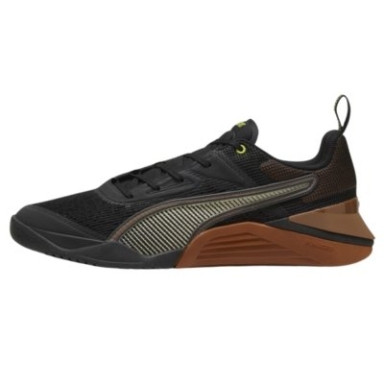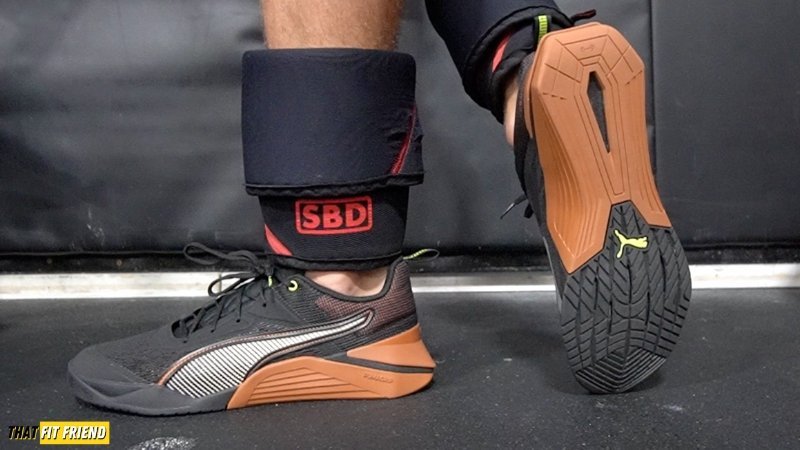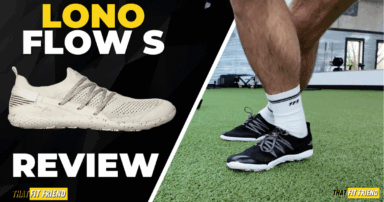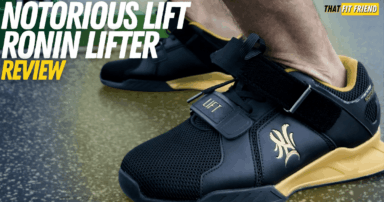That Fit Friend is supported by its readers. I [Jake] run this site myself and buy the gear reviewed. If you purchase through my site, I may earn commissions on sales. Read more here!
I’m not going to lie, the PUMA Fuse 3 took some time to grow on me. After my first session, I actually didn’t love this model but after giving it more time and workouts this shoe steadily grew on me.
I think what threw me off with the Fuse 3 was its snugger fitting toe box out of the box and how it feels pretty heavy. Both of these characteristics gave me pause with this shoe because I liked the Fuse 2 for its flexibility and sock-like fit.
Fortunately, after multiple leg and plyometric-focused workouts, the PUMA Fuse 3’s upper has broken in well and it’s been a lot more tolerable to properly test and review.
Thus far, I’ve squatted 435 lbs, deadlifted 505 lbs, and have hit multiple CrossFit WODs/athletic workouts in the PUMA Fuse 3, and let’s just say, I have some thoughts — some good, some bad.
Fuse 3 Construction Specs to Know
- Heel-to-Toe Drop: 4mm
- Weight: 14.95 oz (size 10 men’s)
- Stack Height: N/A
- Removable Insole: Drop-In Midsole
- Width: Regular/Medium
- Sizing: True to size for narrow, medium, and slightly wider (E-width) feet
- Comparable To Zoom Metcon Turbo 2: Read My Review
My PUMA Fuse 3 Overview
The PUMA Fuse 3 is designed to support your performance when lifting, cross-training, and tackling CrossFit WODs. Over the last three years, PUMA has somewhat been an afterthought when it comes to the market’s top training shoes.
In my opinion, the Fuse 3’s entirely reworked construction shows that PUMA is desperately trying to get their model into the mix regarding the most sought-after models for cross-training. The changes also shadow what a lot of big trainers already do.
For lifting, the PUMA Fuse 3 has been exceptional and it’s been stable enough to support my 400+ lb squats and heavy deadlifts. Granted, you will start to feel the drop-in midsole compress a bit past 400 lbs, but not to a point that hinders performance.
When cross-training and tackling my programmed WODs, the Fuse 3 has also done a good job. This shoe can feel heavy at times and I’ll expand on that below, but I do think the Fuse 3 is a “leveled up” shoe compared to the prior 2 iterations.
If you’re debating between the Fuse 3 and Fuse 2 and the price isn’t a concern and you’re after stability, then I’d opt for the Fuse 3. It feels more built-out and delivers a stronger performance for lifting.
Is the PUMA Fuse 3 right for you? Try my cross-training shoe finder to see if my calculator organically pairs you with the Fuse 3 based on your training needs.
Performance Assessment
For the PUMA Fuse 3, I took this shoe through a variety of tests to assess its stability and versatility. Far too often, I see other review sites/reviewers miss the mark on truly pushing a shoe with its limitations.
Testing the PUMA Fuse 3 for Lifting and CrossFit
In the PUMA Fuse 1 and 2, I pushed their lifting capabilities to a similar place that I tested the Fuse 3 with. I wanted to make sure this model could also handle heavy squats and deadlifts that exceeded 400 lbs.

For most lifters, I think you’ll enjoy the stability that you get with this shoe’s outsole and drop-in midsole. You will start to feel the forefoot compress a little bit when you get 400 lbs but this compression isn’t grandiose and it didn’t lead to a dip in performance.
To add to that, I think reworked midfoot and heel will help give the Fuse 3 a little more stability for lower body movements. You feel locked down in this shoe which I appreciated for my heavy squats and single-leg work.
On top of this, the outsole has good traction and the PUMAGrip delivers once again at biting the floor well when training. Plus, the forefoot is flexible like the Fuse 1 and 2’s which is great when doing split squats and lunges and wanting articulation in your shoes.
In the context of CrossFit, the Fuse 3 has been a good “middle-of-the-road” model. I don’t think this model is going to be a show-stopper in this vertical, but it can hold its own and has done better than the prior two iterations.
With my Fuse 2s, I ripped the midfoot during a rope climb because the rubber got burnt up from friction. In the Fuse 3, I have yet to have this issue and I think that’s due to the midfoot’s rubber being a little more rigid and heavy.
Two WODs that I really hammered in the Fuse 3 included Cindy and Linda. For Cindy, this shoe felt fine and its responsive drop-in midsole felt comfortable for the air squats in this workout and when transitioning through the exercises.
For Linda, I also liked this shoe for the most part. Stability wasn’t an issue for the deadlifts and cleans, but I will say, this model can feel a little heavy so I wasn’t a huge fan of their performance for longer workouts and for adding my interval runs post-Linda.
Testing the PUMA Fuse 3 for Versatile Training
When it comes to versatile training, the PUMA Fuse 3 had decent — for the most part. There are some good and bad things that come along with this shoe for this style of training, in my opinion.
The good revolves around this model’s upper security, drop-in midsole responsiveness, and forefoot flexibility. For my lateral work, I like how this shoe’s upper prevents the foot from spilling over. The sidewalls are also nice for giving you additional lateral support.
When doing things like Cossack squats and skater strides, you notice this feature a lot. The drop-in midsole also does a good job of giving you a nice “bounce” in this shoe. For box jumps, jump rope, and broad jumps, I thought this model felt good through the forefoot.
I think if you’re using these for athletic workouts where you’ll be primarily on the forefoot then you’ll be fine in this model despite its heel feeling a little heavy and clunky at times.
The PUMAGrip on the outsole, and more specifically, the grooves in the forefoot do a good job of moving with the foot. I also appreciate how well this grip does on surfaces like turf and rubber gym floors.

My gripes with this shoe for versatile training revolve around its weight, heel, and narrow toe box. This model can feel heavy on the feet and if you want something that’s more pliable and good for versatile training and lifting then I’d go with the Dropset Trainer 2.
Testing the PUMA Fuse 3 for Short Runs, Daily Wear, and Comfort
The PUMA Fuse 3 works well for short runs if you’re doing sprints or short intervals where you’ll be primarily on the forefoot. In my workouts where I was doing 400-meter bouts on the curved treadmill, I liked the feel of this shoe for the most part.
My issue with the PUMA Fuse 3 — and this is similar to models like the wicked stable Metcon 9 — is that its pronounced feels heavy and clunky. For longer runs where you might have more heel strike mechanics, this can be an issue.
On top of the heel feeling blocky for longer runs, the weight of this shoe is less than stellar for running. I personally like a lighter and more plush ride when running and this model doesn’t truly deliver on that front.
Regarding comfort walking, the PUMA Fuse 3 is not the most uncomfortable training shoe I’ve ever worn. Would I reach for this shoe to walk super long distances because of its comfort, though? No.
However, if you’re someone who just needs a shoe to wear for parts of the day before the gym or after then you’ll be fine in this model. It’s comfortable enough for a few hours of wear without feeling overly tight or heavy.
For example, I’ve worn this shoe on a few occasions where I walked my dog (Maui, featured above!) about 2-3 miles and then went to train. This model felt fine for that context, but I do wish it had a wider toe box as this would give them a more forgiving ride.
What’s Changed In the PUMA Fuse 3?
There have been a lot of construction updates in the Fuse 3 and a lot of these changes were for the better. Granted, these changes, along with our economy, brought the price of this shoe from $100 to $120 — which is also a change.
Fuse 2 to Fuse 3 Major Changes
- Reworked sole: The Fuse 3’s midfoot and heel have been changed. The midfoot is denser and built-out and the heel now features a more squared and rigid construction.
- New upper: In the Fuse 3, you now have a slightly heavier upper construction, a PWRTAPE strip on the medial side of the forefoot, and an asymmetrical lacing system.
- Outsole rework: The Fuse 3’s outsole tread has also been changed. The forefoot is consistent with the PUMA Fuse 1 and 2, but the midfoot and heel have been changed and have less flexibility overall.
- TPU heel clip: There’s a more aggressive TPU clip on the Fuse 3 to promote performance for handstand push-ups. It’s a lot more pronounced and rigid compared to the Fuse 2’s.
Is It Worth Upgrading? My Opinion
I mentioned above that it took me a minute to appreciate the Fuse 3’s updates. However, I’ve since come to enjoy this shoe for what it is and see it as a good “budget” option for lifting and CrossFit-focused athletes.
I think if you’re torn between the PUMA Fuse 2 and Fuse 3 and budget ISN’T a constraint, then I’d go newer in this context. The Fuse 3 just feels like a stronger training shoe. It feels kind of similar to the Nike Metcon 7 and 8.
If budget is a constraint and you like the Fuse 2 and it has a cheap price point then I don’t think you can’t go wrong with that model either. It’s a good generalist for lifters wanting to spend less than $100.
PUMA Fuse 3 Sizing
- PUMA Fuse 3 Sizing Advice: True to size for most.
I think for most athletes and lifters, you should be safe going true to size in the PUMA Fuse 3. More specifically, if you have narrow, medium, and even slightly wider (E-width) feet then you’ll be fine going true to size.
This model took about a week to break in and I have an E-width and I felt like they were super snug out of the box. Even now, I like to wear thinner socks with this model to give myself more room.
If you currently wear the PUMA Fuse 1 and 2, then go with the same size you currently wear in the Fuse 3. Expect this shoe to have a lower profile feeling with its upper construction.
My One Sizing Concern…
For my wide-feet friends, I would say tread lightly with this model. The toe box is pretty aggressive with its taper, and to be quite honest, there are stronger models on the market that fit more widely.
For example, if you want a flatter feeling shoe with a wide toe box, opt for the Born Primitive Savage 1 and if you need width with a lot of upper volume then go with the VIKTOS Core Gym.
Before you buy, hit me if you have questions about the Fuse 3’s sizing. Let me know what you currently wear and in what size in the comments below and I can help.
Construction Details
Midsole and Outsole
Instead of a traditional midsole, you have a drop-in midsole with the Fuse 3. This essentially means that the insole in this model also serves as the midsole. The forefoot form is more plush and the heel is denser for stability purposes.
I find drop-in midsole to be pretty polarizing at times. Some athletes like them and don’t mind and others tend to despise them. So far, this drop-in midsole has done a good with performance and security and hasn’t slid or squeaked too much.
The outsole of this shoe is built with PUMAGrip which is PUMA’s proprietary grippy rubber material they use in their Fuse line. The forefoot has grooves which helps with this shoe’s flexibility.
The midfoot and heel are a little denser and have less flexibility, especially at the heel. There’s also a cut-out in the heel where you can see the footbed. This rubber feels more durable than the prior Fuse outsoles.
Upper and Laces
The Fuse 3’s upper is built with mesh, textile, and synthetic materials. The forefoot and midfoot feature a breathable mesh and there are synthetic and textile overlays covering the toe box and midfoot.
The upper on this model definitely feels more rigid than the Fuse 2’s upper. However, this upper still breathes pretty well so I don’t think breathability will be an issue for most in this shoe.
The padded mesh tongue is gusetted and there are five core eyelets on this model. The lacing system is built asymmetrically and sits offset on the lateral side of the foot. I don’t mind the security of this shoe despite not typically liking this type of lacing system
Frequently Asked Questions (FAQ)
Q:Are the PUMA Fuse 3 good for lifting?
Q:Can you use the PUMA Fuse 3 for CrossFit?
Final Verdict
The PUMA Fuse 3 is a step in the right direction for the Fuse shoe line. This model is starting to feel more like a modern-day cross-training shoe that’s built for lifting and CrossFit.
With a more stable feeling and improved durability, I see the Fuse 3 as a good middle-of-the-pack training shoe for the athlete and lifter who needs a versatile gym shoe for heavy-strength work.
If you have additional questions on the Fuse 3, drop a comment below or reach out to me via Instagram (@jake_boly or @that_fit_friend).





















Theo Dehoyos
This shoe is heavy AF, but it doesn’t make me shy away from doing anything. WODs with weightlifting and short running are great with these. So are body weight movements